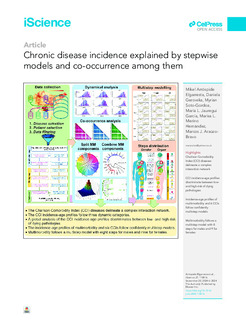
Título
Chronic disease incidence explained by stepwise models and co-occurrence among themAutor-a
Autor-a (de otra institución)
Fecha de publicación
2024Versión
Version publicadaTipo de documento
ArtículoArtículoIdioma
InglésDerechos
© 2024 The AuthorsAcceso
Acceso abiertoVersión de la editorial
https://doi.org/10.1016/j.isci.2024.110816Publicado en
iScience Vol. 27. N. 9. N. art. 110816, 2024Editorial
ElsevierPalabras clave
Pathophysiologybioinformatics
Clasificación UNESCO
EpidemiologíaSalud pública
Resumen
Multimorbidity (MM) is the co-occurrence of two or more chronic diseases. We provided a dynamic approach revealing the MM complexity constructing a multistep incidence-age model for all patients with ... [+]
Multimorbidity (MM) is the co-occurrence of two or more chronic diseases. We provided a dynamic approach revealing the MM complexity constructing a multistep incidence-age model for all patients with MM between 2014 and 2021 in the Basque Health System, Spain. The multistep model, with eight steps for males and nine for females, is a very well-fitting representation of MM. To gain insight into the MM components, we modeled the 19 diseases used to calculate the Charlson Comorbidity Index (CCI). We observed that the CCI diseases formed a complex interaction network. Hierarchical clustering of the incidence-age profiles clustered the CCI diseases into low- and high-risk of dying pathologies. Diseases with a higher number of steps are better represented by a multistep model. Anatomically, diseases associated with the central nervous system have the highest number of steps, followed by those associated with the kidney, heart, peripheral vasulature, pancreas, joints, cerebral vasculature, lung, stomach, and liver. [-]
Colecciones
- Artículos - Ingeniería [763]
El ítem tiene asociados los siguientes ficheros de licencia:





















